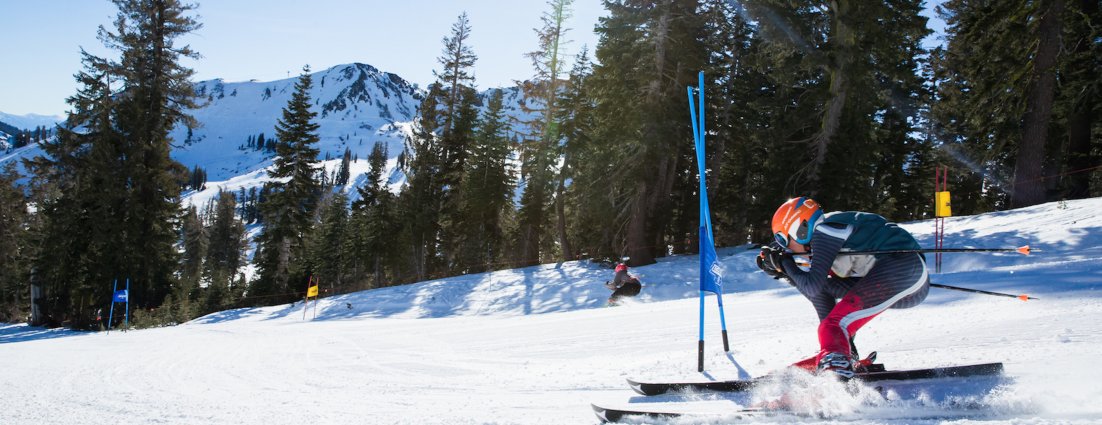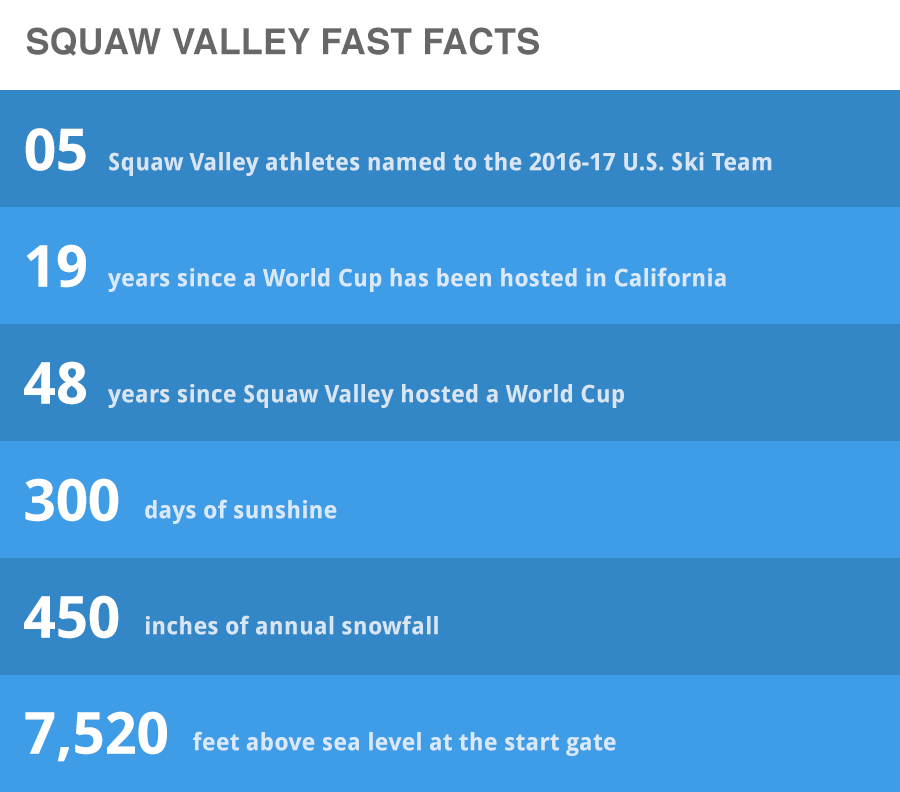3 Reasons Squaw Valley Produces So Many Olympians
03.07.2017 | Ski Racing Staff

Professional ski racing returned to California for the first time in 19 years last winter and Squaw provided an amazing opportunity to watch the best of the best race on the iconic Red Dog run. Squaw Valley has a history of hosting major events including the 1960 Winter Olympic Games. The Lake Tahoe resort is filled with incredible athletes like Tamara McKinney, the first American woman to win the World Cup overall title, current U.S. Ski Team champion Travis Ganong and NASTAR Pacesetter Marco Sullivan to name a few.
What is it about Squaw Valley that makes it the ultimate place to develop elite ski racers?
The Mountain
With 6,600 skiable acres, more than 270 trails and one of the longest ski seasons in the country, Squaw Valley and its sister mountain Alpine Meadows boast nearly infinite training opportunities. Athletes develop endurance by skiing down Squaw’s longest run, which extends 3.2 miles, and hone their balance skills while skiing the extensive off-piste terrain.
“I would say the mountain, itself, is just a coach of its own,” says current U.S. Ski Team athlete Keely Cashman. “I think the whole entire mountain has some terrain that you can’t get anywhere else and the people at Squaw, too, are a lot different than anywhere else. They’re really relaxed and they just love skiing and that part of Squaw is what really shapes the athletes that come from there.”
McKinney has distinct memories of shredding down slopes like KT-22 with her brother and coach during her early years.
“I have great memories of skiing with my coach, Phillippe Mollard, making high-speed GS turns through a mogul field on Siberia,” McKinney recalls. “Also skiing with my brother, Steve, who had the world speed skiing record at the time, on KT, skiing at speed through the chop.”
Current American Downhiller Bryce Bennett skis some of the most challenging race slopes in the world including the Streif at Kitzbuehel. Red Dog, where the 2017 women’s World Cup races will be hosted, helped him build up his stamina for those tracks.
“That’s where we did most of our early morning training,” he recalls. “I remember we used to set 100-gate slaloms down Red Dog, and the rule was you had to finish three before you could go inside. We would train GS there all the time. It was never easy. It was always hard, bumpy, chattery.”
The Red Dog run is one of the great mentors for young athletes. Two-time Olympian Edie Thys Morgan says it is as challenging as any run on the World Cup circuit.
“It’s pretty tough,” she says. “It stacks right up there with the best of them for women. The nice thing about it is that it does finish right in the heart of Squaw. You can see probably two-thirds of the course – or at least half of it – from the bottom, so it should be pretty exciting.”
The Legacy
Nearly 60 years ago, Squaw Valley hosted the Winter Olympic Games – an honor that still shines through when visitors enter the resort, the Olympic flame burning at the base of Squaw Valley Road and the Olympic rings greeting every skier who drives into the village.
While Morgan now resides in New Hampshire with her family, she was born and raised in sunny California and got her start in ski racing at Squaw Valley. She remembers growing up in the afterglow of the 1960 Olympics.
“When I was there, it was the direct carryover from the ‘60 Olympics,” she shares. “The people of all nations had stuck around. You know, there were Argentinians, there were Swiss, and there were Austrians and there were French, and they’d all stuck around and then you just had this wealth of experience and that was in coaching and just in visual images around you all the time.”
McKinney is a prominent part of that legacy thanks to her World Championship alpine combined gold medal in 1989 and her three World Cup discipline globes.
“Growing up in Squaw the mountain was my playground,” she says. “The generations of Olympians from Squaw Valley before me, starting with Jimmie Heuga, Eric and Sandra Poulsen, Greg Jones. All were heroes who made the idea of World Cup and Olympic goals tangible.”
The return of the World Cup meant that the legacy continued as the best in the world once again left their mark on this historic mountain and inspired the next generation of athletes.
“It was amazing to have the World Cup come back to Squaw Valley,” McKinney says. “The Poulsens were racing the last time the World Cup was here in 1969. Having the World Cup here showcased what a spectacular mountain Squaw Valley is, and it was also a way for young racers to see world class skiing in person. If you can see it, ski it, anything is possible.”
The Vibe
Squaw Valley embodies the philosophy manifested in the hashtag #GoodVibesOnly. With 300 days of sunshine a year, even the biggest pessimist is forced to crack a smile. That atmosphere translates over to the race team.
“It’s a really fun atmosphere and a really cool team to be a part of – a lot more laid back than a lot of other programs.,” says Ganong. “Here it’s all about finding what works for you – the style of skiing that works for you and what you enjoy, and it always comes back to having fun. And I think that’s why we’ve had a lot of success here at Squaw and why we’ve had so many U.S. Ski Team members come out of here.”
"Along with the freedom for athletes to forge their own path, the sense of family at Squaw provides athletes the necessary support network to pursue their dreams. Edie Thys Morgan says that support is what personally helped her get to the national team.
“It’s great to have all the pieces in place to build a great skier, but then you have to have the support in place for when things aren’t going well because everyone runs up against that,” she recalls. “I ran up against the wall that everyone runs up against and when that happened, I had my family right there, but then I had this extended family of coaches and other athletes.”
The network of Squaw team members as well as friends from throughout the Tahoe area helped lift Morgan out of her slumps. At the end of the day, racers at Squaw have a passion for skiing that extends outside the gates.
“Growing up at Squaw, I remember just how much fun we used to have,” Bennett shares. “We had such a big group of kids, and really good kids, and we always enjoyed skiing, and that was what was important to us ¬– going out and skiing and skiing hard and pushing each other. It was just an incredible place to grow up and learn how to ski and that transferred into ski racing.”
The Lake Tahoe ski racing community’s love of the sport, which Bennett describes, is no doubt what spurred the return of the World Cup to Squaw Valley.
